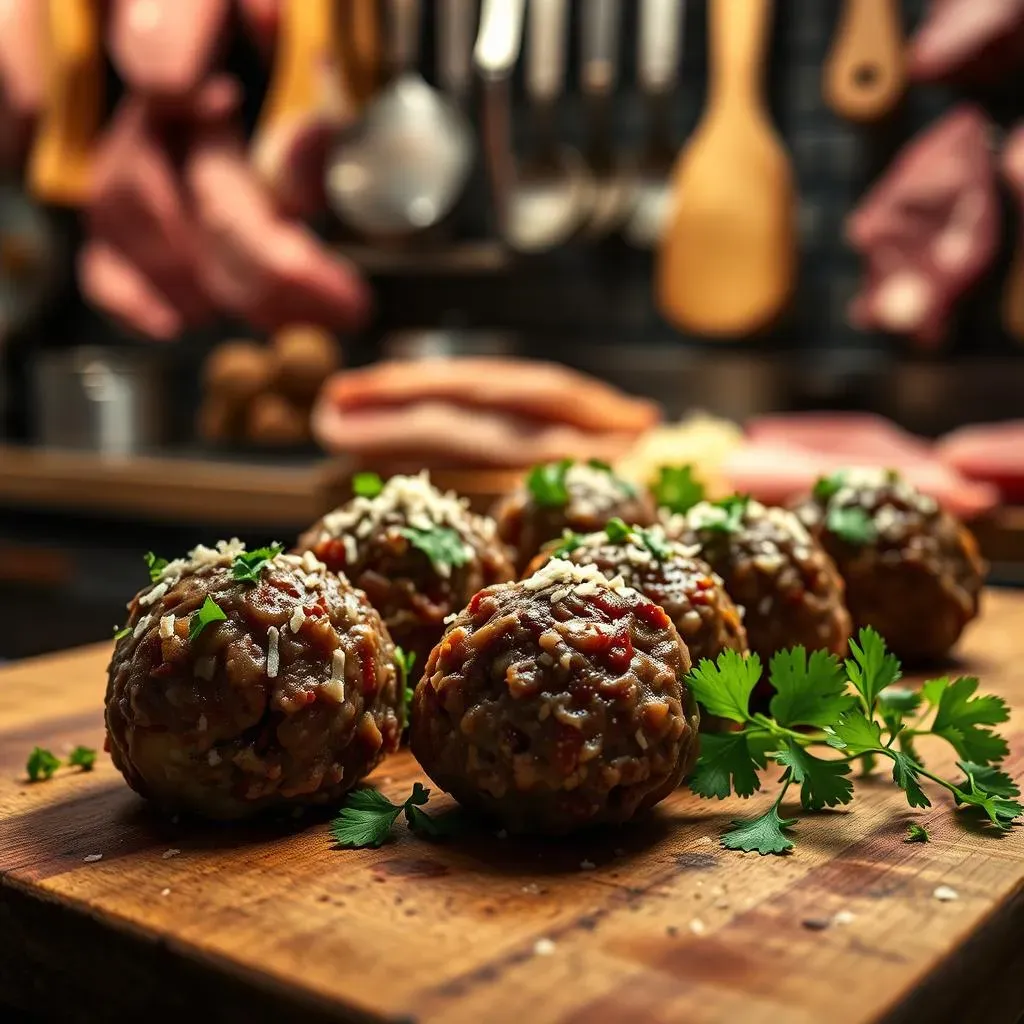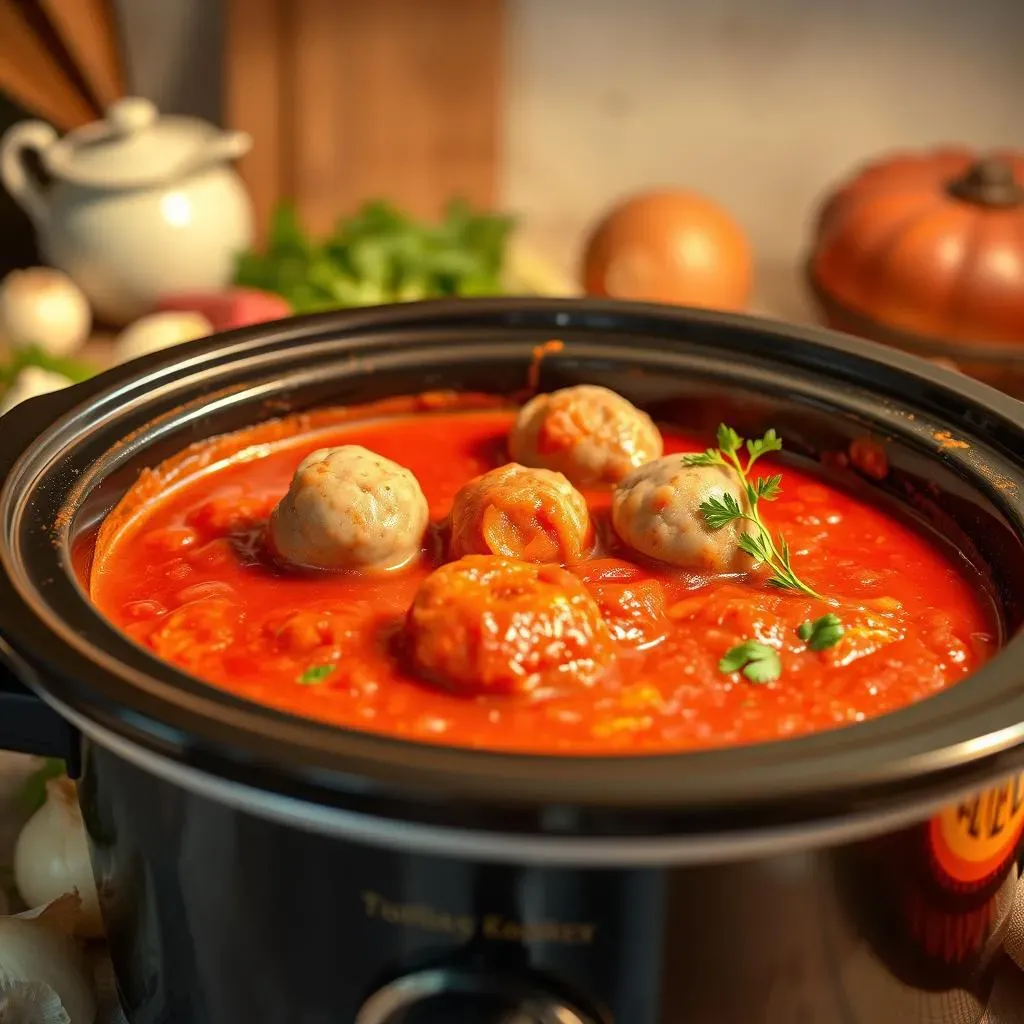Table of Contents
Craving a comforting, flavorful meal that's also incredibly easy to make? Then you've come to the right place! This article is your ultimate guide to crafting the perfect slow cooker beef meatballs. We'll walk you through everything from selecting the best beef for your recipe to creating mouthwatering sauces that go beyond the typical spaghetti. Forget spending hours slaving over a hot stove; with our simple, step-by-step instructions for this beef meatball recipe slow cooker, you'll have a delicious, tender, and juicy masterpiece ready in a fraction of the time. We'll explore various techniques for mixing and shaping your meatballs, ensuring they stay perfectly plump and flavorful throughout the slow cooking process. And get ready to be amazed by the creative sauce options we'll explore – think beyond the standard tomato sauce! We'll also give you plenty of ideas on how to serve these amazing meatballs, moving far beyond the classic spaghetti and meatballs combination. So, grab your apron, gather your ingredients, and let's embark on a culinary adventure together!
Choosing Your Beef: A Meatball Primer

Choosing Your Beef: A Meatball Primer
Ground Beef Grades: Understanding the Options
Choosing the right ground beef is crucial for juicy, flavorful meatballs. Think of it like this: you wouldn't build a house with flimsy materials, right? The same goes for meatballs. You've got a few main options: 80/20 (80% lean, 20% fat), 85/15, and 90/10. The higher the percentage of lean meat, the less fat you'll have. Less fat means leaner meatballs, but it *also* means they might be a little drier. For the perfect balance of flavor and moisture, I usually recommend 80/20 – it's the Goldilocks of ground beef choices. Too lean, and your meatballs will be dry and crumbly. Too fatty, and they'll be greasy. 80/20 hits that sweet spot.
Don't be afraid to experiment! Some people prefer a leaner meatball, and that's perfectly fine. If you're aiming for a leaner option, you could always mix lean ground beef with ground turkey or chicken for a healthier twist. Check out our 1 lb ground beef meatball recipe for a great starting point.
Ground Beef Grade | Lean/Fat Ratio | Meatball Texture |
|---|---|---|
80/20 | 80% Lean, 20% Fat | Juicy and flavorful |
85/15 | 85% Lean, 15% Fat | Leaner, slightly drier |
90/10 | 90% Lean, 10% Fat | Leanest, may be dry |
Beyond Ground Beef: Exploring Other Options
While ground beef is the classic choice, don't limit yourself! Think outside the box (or the meat counter). Adding other ground meats can significantly enhance the flavor and texture of your meatballs. Ground pork, for instance, adds a delightful richness and juiciness. A blend of beef and pork is a popular choice for a reason – it's a match made in meatball heaven! You could also experiment with ground lamb for a more exotic flavor profile. Want something a bit different? Try our beyond beef meatball recipe for a unique culinary adventure!
The key here is to find a balance. Don't just throw in a bunch of different meats without considering the overall flavor profile. Start with a small amount of your chosen addition and adjust to your taste. Remember, the goal is to create a harmonious blend of flavors that complement each other. A little experimentation goes a long way! Plus, it's a fantastic way to use up any leftover ground meat you might have in the fridge.
- Ground Pork: Adds richness and juiciness.
- Ground Lamb: Offers a unique, savory flavor.
- Ground Turkey or Chicken: Leaner options for a healthier twist.
Sourcing Your Meat: Quality Matters
Just like choosing the right grade, where you buy your meat matters. Opt for a butcher or grocery store known for its quality meat. Look for bright red beef that's firm to the touch; avoid anything that looks dull or slimy. Freshness is key – the fresher the meat, the better your meatballs will taste. Think of it as the foundation of your culinary masterpiece – you wouldn't build a castle on sand, would you?
Consider buying your meat in bulk if you make meatballs often. This can often save you money and give you the chance to experiment with different cuts and blends. You can easily freeze extra ground meat in portions suitable for your recipes. Remember to always store your meat properly to ensure freshness and prevent spoilage. This will ensure you're always ready for your next meatball adventure! For more ideas, check out our beef meatball recipe variations page.
The Art of the Meatball: Mixing and Shaping

The Art of the Meatball: Mixing and Shaping
Mixing Your Meatball Magic
Alright, let's get our hands dirty! Mixing the meatball ingredients is where the real fun begins. It's not just about throwing everything into a bowl; it's about creating a cohesive, flavorful mixture that will hold its shape during cooking. Think of it like baking a cake – you wouldn't just dump all the ingredients together, would you? You need to gently combine them to ensure a smooth, even texture. For meatballs, that means using a light hand and avoiding overmixing. Overmixing can make your meatballs tough, so be gentle!
Start by combining your chosen ground meats in a large bowl. Then, add your binding agents – things like breadcrumbs, eggs, or even a little milk or buttermilk. These ingredients help the meatballs hold their shape. Next, incorporate your seasonings – garlic, onion powder, herbs, spices – whatever your heart desires! Remember, this is your chance to get creative and add your personal touch. For more ideas on seasonings, check out our beef meatball recipe tips page. Don't forget to taste as you go, adjusting seasonings until you achieve the perfect flavor balance. It's all about creating a delicious symphony of flavors.
- Gently combine ingredients to avoid tough meatballs.
- Use binding agents like breadcrumbs or eggs.
- Season generously and taste as you go.
Shaping Your Meatball Masterpieces
Now comes the artistry – shaping your meatballs! This is where you can really show off your culinary skills. Consistency is key here. Aim for uniform size – this ensures even cooking. Too big, and the inside might stay raw. Too small, and they might dry out. I usually recommend aiming for meatballs that are about 1.5 to 2 inches in diameter. You can use a meatball scoop or simply roll them by hand. If you're using a meatball scoop, make sure to pack the meat firmly.
Once you've shaped your meatballs, gently place them on a plate or baking sheet lined with parchment paper. Avoid overcrowding them, as this can hinder even cooking. If you're planning to brown them before adding them to the slow cooker, make sure to leave enough space between each meatball for good airflow. If you're short on time or prefer a simpler approach, you can skip the browning step entirely. Many recipes work perfectly well without it. For another great option, check out our easy beef meatball recipe.
Meatball Size | Cooking Time | Notes |
|---|---|---|
1.5-2 inches | Even cooking | Recommended size |
Larger | Longer cooking time, may be undercooked inside | Requires careful monitoring |
Smaller | May dry out quickly | Best for appetizers or smaller portions |
Slow Cooker Sauces: Beyond the Basics

Slow Cooker Sauces: Beyond the Basics
Classic Tomato Sauce, Elevated
Let's start with the classic: tomato sauce. But we're not talking about your average jarred stuff. We're talking about a slow-cooked, deeply flavorful tomato sauce that will make your meatballs sing. The slow cooker is your secret weapon here – it allows the flavors to meld and deepen over time, creating a rich and complex sauce that's far superior to anything you can whip up quickly on the stovetop. Start with good quality canned crushed tomatoes, a touch of tomato paste for richness, and then get creative with your additions. A little onion, garlic, and some fresh herbs can transform a simple tomato sauce into a culinary masterpiece.
Think about adding a touch of sweetness with a splash of balsamic vinegar or a teaspoon of sugar. A pinch of red pepper flakes will add a subtle kick. Or, for a more complex flavor, try adding a tablespoon of Worcestershire sauce. The possibilities are endless! Don’t forget to season generously with salt and pepper, and remember to taste as you go. For a more advanced tomato sauce, check out this Italian meatball recipe that utilizes a rich tomato base.
- Canned crushed tomatoes
- Tomato paste
- Onion and garlic
- Fresh herbs (basil, oregano, parsley)
- Balsamic vinegar or sugar (optional)
- Red pepper flakes (optional)
- Worcestershire sauce (optional)
Beyond Tomato: Exploring Unique Flavor Profiles
Now, let's get adventurous! Why limit yourself to tomato sauce when the world of slow cooker sauces is your oyster? Think creamy mushroom sauce, a rich and decadent gravy, or even a tangy BBQ sauce. The possibilities are as vast as your imagination. A creamy mushroom sauce, for instance, pairs beautifully with beef meatballs and adds a luxurious touch. Simply sauté some mushrooms with onions and garlic, then simmer them in a rich cream sauce with a touch of white wine or chicken broth for extra depth. It’s a simple yet sophisticated sauce that elevates your meatballs to a whole new level.
For a hearty and comforting meal, try a slow cooker gravy. This is a great option for a cold-weather meal. Start with beef broth or stock, then add in your favorite seasonings. A little bit of flour can help thicken the gravy, and you can add other vegetables like carrots or celery for extra flavor. If you're feeling adventurous, try a tangy BBQ sauce. The sweetness and smokiness of the BBQ sauce complement the savory flavor of the beef meatballs perfectly. For another unique twist, check out our beef meatball casserole recipe which uses a unique creamy sauce.
Sauce Type | Key Ingredients | Flavor Profile |
|---|---|---|
Creamy Mushroom | Mushrooms, cream, white wine | Rich, earthy, luxurious |
Hearty Gravy | Beef broth, flour, vegetables | Savory, comforting, hearty |
Tangy BBQ | BBQ sauce, brown sugar, spices | Sweet, smoky, tangy |
Serving Suggestions and Recipe Variations: Beyond Spaghetti

Serving Suggestions and Recipe Variations: Beyond Spaghetti
Serving Suggestions and Recipe Variations: Beyond Spaghetti
Let's face it, spaghetti and meatballs is a classic for a reason, but it's time to expand our horizons! These slow-cooked beef meatballs are incredibly versatile and can be incorporated into a huge range of dishes. Think beyond the pasta and explore exciting new culinary avenues. For a quick and easy weeknight meal, serve your meatballs over mashed potatoes, creamy polenta, or even a bed of fluffy rice. The rich, savory flavors of the meatballs pair beautifully with the creamy textures of these sides, creating a harmonious blend of tastes and textures. Want something a bit more substantial? Try using your slow cooker meatballs to create a hearty meatball sub. Pile them high on a crusty roll with your favorite cheese and toppings – it’s a simple yet satisfying meal that’s perfect for a casual lunch or dinner.
Feeling adventurous? Try incorporating your meatballs into a pizza topping! The slow-cooked meatballs add a delightful depth of flavor, and the combination of the rich meatball sauce and melted cheese is irresistible. Alternatively, you can try our beef meatball pizza recipe for a fun twist on a classic. Or, if you're looking for something lighter, try using your slow-cooked meatballs in a salad. The warm meatballs add a satisfying contrast to the cool, crisp vegetables. A simple green salad with a vinaigrette dressing is a perfect complement to the rich and savory meatballs. For more unique serving ideas, check out our beef meatball recipe variations.
- Mashed Potatoes
- Creamy Polenta
- Fluffy Rice
- Meatball Subs
- Pizza Topping
- Salads
Beyond the serving suggestions, let's talk about recipe variations. The beauty of slow cooker meatballs lies in their adaptability. Feel free to experiment with different herbs and spices to create your own unique flavor profiles. A dash of Italian seasoning, a sprinkle of paprika, or a pinch of cayenne pepper can completely transform the flavor of your meatballs. Don't be afraid to try new things! For example, you could add a tablespoon of Dijon mustard to your meatball mixture for a tangy twist. Or, you can add a handful of chopped sun-dried tomatoes for a burst of Mediterranean flavor. The possibilities are endless!
Consider adding different vegetables to your sauce. A handful of chopped mushrooms, some diced carrots, or even some spinach can add a layer of depth and nutrition to your slow-cooked meatballs. For instance, adding finely chopped bell peppers adds a touch of sweetness and vibrancy to the sauce, while finely diced zucchini adds a subtle freshness that complements the meatball's richness. Experiment with different types of cheese as well. A sprinkle of Parmesan cheese adds a salty and savory flavor that pairs well with the richness of the meatballs. For a spicier kick, try adding a pinch of crushed red pepper flakes. For a complete change of pace, try our beef meatball pho recipe for a unique Asian-inspired twist.
Variation | Ingredient | Flavor Profile |
|---|---|---|
Spicy Kick | Crushed Red Pepper Flakes | Adds heat and zest |
Tangy Twist | Dijon Mustard | Adds a sharp, savory flavor |
Mediterranean Flair | Sun-dried Tomatoes | Adds sweetness and acidity |